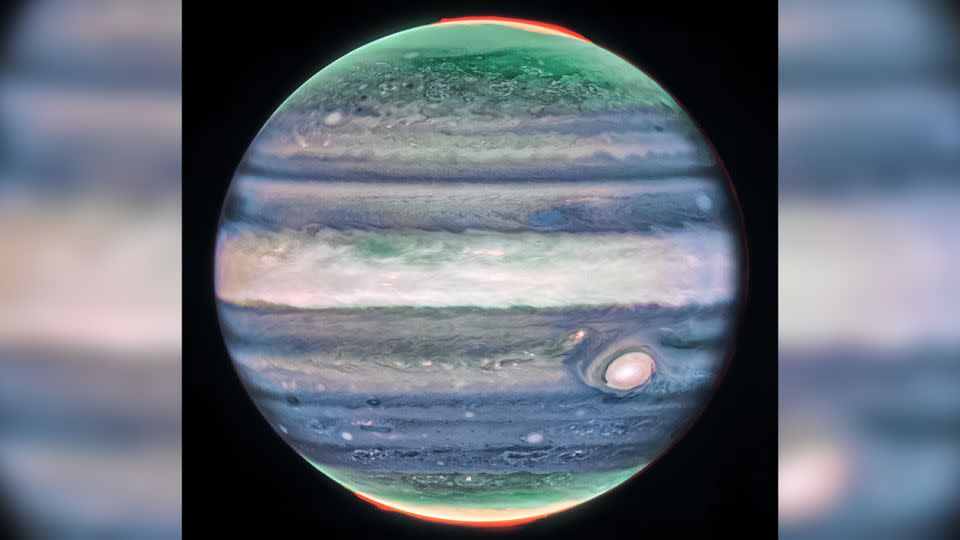Webb telescope spots never-before-seen feature in Jupiter’s atmosphere

Sign up for CNN’s Wonder Theory science newsletter. Explore the universe with news on fascinating discoveries, scientific advancements and more.
Jupiter was one of the first targets observed by the James Webb Space Telescope when it initially turned its infrared gaze on the universe in July 2022. After capturing stunning images that surpassed the expectations of astronomers, the space observatory has now revealed a never-before-seen feature in the gas giant’s atmosphere.
Researchers used Webb’s Near-Infrared Camera, or NIRCam, to take a series of images of Jupiter 10 hours apart, applying four different filters to detect changes in the planet’s atmosphere. Infrared light is invisible to the human eye, and the Webb telescope’s unprecedented capabilities have been used over the past year to spot many newly observed celestial features, such as megaclusters of young stars and unexpected pairs of planetlike objects.
The astronomers spied a high-speed jet stream in Jupiter’s lower stratosphere, an atmospheric layer about 25 miles (40 kilometers) above the clouds. The jet stream, which sits over the planet’s equator, spans more than 3,000 miles (4,800 kilometers) wide and moves at 320 miles per hour (515 kilometers per hour), or twice the rate seen with sustained winds of a Category 5 hurricane on Earth.
The study findings, made possible by Webb’s sensitive capabilities, shed light on the dynamic interactions within Jupiter’s stormy atmosphere.
“This is something that totally surprised us,” said Ricardo Hueso, lead author of the study published October 19 in the journal Nature Astronomy, in a statement. Hueso is a physics lecturer at the University of the Basque Country in Bilbao, Spain.
“What we have always seen as blurred hazes in Jupiter’s atmosphere now appear as crisp features that we can track along with the planet’s fast rotation,” he said.
Jupiter’s wild weather
Jupiter is the largest planet in our solar system and is composed of gases, so it couldn’t be more different from Earth. But similar to our planet, Jupiter has a layered atmosphere. These turbulent layers have been observed by previous missions and telescopes attempting to better understand how the different parts of the atmosphere interact with one another. The layers also contain weather patterns, including century-spanning storms such as Jupiter’s Great Red Spot and clouds made of icy ammonia.
While other missions have penetrated deeper into Jupiter’s swirling clouds by using different wavelengths of light to peer beneath them, Webb is uniquely positioned to study the higher-altitude layers, about 15 to 30 miles (25 to 50 kilometers) above the cloud tops, and spy previously indistinct details.
“Even though various ground-based telescopes, spacecraft like NASA’s Juno and Cassini, and NASA’s Hubble Space Telescope have observed the Jovian system’s changing weather patterns, Webb has already provided new findings on Jupiter’s rings, satellites, and its atmosphere,” said study coauthor Imke de Pater, professor emeritus of astronomy, Earth and planetary science at the University of California, Berkeley, in a statement.
Jet stream revelations
Researchers compared winds detected by Webb at high altitudes with those within the lower layers picked up by Hubble and tracked changes in wind speed. Both space observatories were necessary to detect the jet stream, as Webb spotted small cloud features and Hubble provided a look at the equatorial atmosphere, including storms not related to the jet. The two telescopes provided a broader look at Jupiter’s complex atmosphere and the processes taking place within the layers.
“We knew the different wavelengths of Webb and Hubble would reveal the three-dimensional structure of storm clouds, but we were also able to use the timing of the data to see how rapidly storms develop,” said study coauthor Michael Wong, planetary scientist at the University of California, Berkeley, who led the associated Hubble observations, in a statement.
Future observations of Jupiter using the Webb telescope may uncover more insights into the jet stream, such as whether its speed and altitude shift over time, as well as other surprises.
“It’s amazing to me that, after years of tracking Jupiter’s clouds and winds from numerous observatories, we still have more to learn about Jupiter, and features like this jet can remain hidden from view until these new NIRCam images were taken in 2022,” said study coauthor Leigh Fletcher, professor of planetary science at the University of Leicester in the United Kingdom, in a statement.
“Jupiter has a complicated but repeatable pattern of winds and temperatures in its equatorial stratosphere, high above the winds in the clouds and hazes measured at these wavelengths. If the strength of this new jet is connected to this oscillating stratospheric pattern, we might expect the jet to vary considerably over the next 2 to 4 years — it’ll be really exciting to test this theory in the years to come.”
For more CNN news and newsletters create an account at CNN.com

